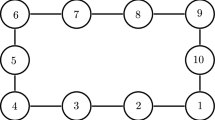Abstract
The consensus problem for general linear multi-agent systems (MASs) under directed topology is investigated. First, a novel consensus protocol based on proportional-integral-derivative (PID) control is proposed. Second, the consensus problem is converted into an asymptotic stability problem through transformations. Third, through a state projection method the consensus condition is proved and the explicit expression of the consensus function is given. Then, a Lyapunov function is constructed and the gain matrices of the protocol are given based on the linear matrix inequality. Finally, two experiments are conducted to explain the advantages of the method. Simulation results show the effectiveness of the proposed algorithm.
Similar content being viewed by others
References
Andreasson, M., Sandberg, H., Dimarogonas, D.V., et al., 2012. Distributed integral action: stability analysis and frequency control of power systems. 51st Proc. IEEE Conf. on Decision and Control, p.2077–2083. https://doi.org/10.1109/CDC.2012.6426463
Cai, H., Huang, J., 2014. The leader-following attitude control of multiple rigid spacecraft systems. Automatica, 50(4): 1109–1115. https://doi.org/10.1016/j.automatica.2014.01.003
Chen, K.R., Wang, J.W., Zhang, Y., et al., 2015. Consensus of second-order nonlinear multi-agent systems under state-controlled switching topology. Nonl. Dynam., 81(4): 1871–1878. https://doi.org/10.1007/s11071-015-2112-3
Cheng, L., Wang, Y., Ren, W., et al., 2015. Containment control of multiagent systems with dynamic leaders based on a PIn type approach. IEEE Trans. Cybern., 46(12): 3004–3017. https://doi.org/10.1109/TCYB.2015.2494738
Daniel, B., Mario, D., 2014. Distributed PID control for consensus of homogeneous and heterogeneous networks. IEEE Trans. Contr. Netw. Syst., 22(2): 154–163. https://doi.org/10.1109/TCNS.2014.2378914
Fax, J.A., Murray, R.M., 2004. Information flow and cooperative control of vehicle formations. IEEE Trans. Autom. Contr., 49(9): 1465–1476. https://doi.org/10.1109/TAC.2004.834433
Ji, L., Liao, X., 2013. Consensus problems of first-order dynamic multi-agent systems with multiple time delays. Chin. Phys. B, 4(22): 040203. https://doi.org/10.1088/1674-1056/22/4/040203
Li, Z.K., Ren, W., Liu, X.D., et al., 2013. Distributed consensus of linear multi-agent systems with adaptive dynamic protocols. Automatica, 49(7): 1986–1995. https://doi.org/10.1016/j.automatica.2013.03.015
Lin, Z.J., Hong, T., Liu, H., 2015. Consensus based on learning game theory with a UAV rendezvous application. Chin. J. Aeronaut., 28(1): 191–199. https://doi.org/10.1016/j.cja.2014.12.009
Liu, Y.F., Geng, Z.Y., 2015. Finite-time formation control for linear multi-agent systems: a motion planning approach. Syst. Contr. Lett., 85(9): 54–60. https://doi.org/10.1016/j.sysconle.2015.08.009
Lombana, D.A.B., di Bernardo, M., 2015. Distributed PID control for consensus of homogeneous and heterogeneous networks. IEEE Trans. Contr. Netw. Syst., 2(2): 154–163. https://doi.org/10.1109/TCNS.2014.2378914
Mu, X.W., Yang, Z., Liu, K., et al., 2015. Containment control of general multi-agent systems with directed random switching topology. J. Franklin Inst., 352(10): 4067–4080. https://doi.org/10.1016/j.jfranklin.2015.05.039
Olfati-Saber, R., 2006. Flocking for multi-agent dynamic systems: algorithms and theory. IEEE Trans. Autom. Contr., 51(3): 401–420. https://doi.org/10.1109/TAC.2005.864190
Olfati-Saber, R., Fax, J.A., Murray, R.M., 2007. Consensus and cooperation in networked multi-agent systems. Proc. IEEE, 95(1): 215–233. https://doi.org/10.1109/JPROC.2006.887293
Ren, W., Beard, R.W., 2005. Consensus seeking in multiagent systems under dynamically changing interaction topologies. IEEE Trans. Autom. Contr., 50(5): 655–661.
Ren, W., Beard, R., Atkins, E., 2007. Information consensus in multivehicle cooperative control. IEEE Contr. Syst., 27(2): 71–82. https://doi.org/10.1109/MCS.2007.338264
Ruggero, C., Edoardo, D., Sandro, Z., 2011. A PI controller based on asymmetric gossip communications for clocks synchronization in wireless sensors networks. 50th IEEE Conf. on Decision and Control and European Control, p.7512–7517. https://doi.org/10.1109/CDC.2011.6161101
Sam, S., Khan, U.A., 2015. Leader-follower consensus in mobile sensor networks. IEEE Signal Process. Lett., 22(12): 2249–2253. https://doi.org/10.1109/LSP.2015.2474134
Su, H.S., Zhang, W., 2008. Second-order consensus of multiple agents with coupling delay. 7th World Congress on Intelligent Control and Automation, p.7181–7186. https://doi.org/10.1109/WCICA.2008.4594034
Sun, G., 2012. Second-order consensus of multiple agents with bounded control inputs and preserved network connectivity. Commun. Theor. Phys., 57(4): 624–628. https://doi.org/10.1088/0253-6102/57/4/18
Wang, Y., Cheng, L., Hou, Z., et al., 2015. Coordinated transportation of a group of unmanned ground vehicles. 34th Chinese Control Conf., p.7027–7032. https://doi.org/10.1109/ChiCC.2015.7260750
Yang, C.X., Hong, W.X., Huang, L.Y., et al., 2014. Fast consensus tracking of multiagent systems with diverse communication delays and input delays. Math. Probl. Eng., 2014: 1–10. https://doi.org/10.1155/2014/253806
Yang, X.G., Xi, J.X., Wu, J.Y., et al., 2015. Consensus transformation for multi-agent systems with topology variances and time-varying delays. Neurocomputing, 168(5): 1059–1064. https://doi.org/10.1016/j.neucom.2015.05.018
Zhang, H., Yang, R., Yan, H., et al., 2015. H ∞ consensus of event-based multi-agent systems with switching topology. Inform. Sci., 370(24): 623–635. https://doi.org/10.1016/j.ins.2015.11.019
Zhang, H.T., Cheng, Z.M., Chen, G.R., 2015. Model predictive flocking control for second-order multi-agent systems with input constraints. IEEE Trans. Circ. Syst. I, 62(6): 1599–1606. https://doi.org/10.1109/TCSI.2015.2418871
Author information
Authors and Affiliations
Corresponding author
Additional information
Project supported by the National Natural Science Foundation of China (No. 50875132)
Rights and permissions
About this article
Cite this article
Li, Hl., Yang, Rn. & Li, Qn. Designing a novel consensus protocol for multiagent systems with general dynamics under directed networks. Frontiers Inf Technol Electronic Eng 18, 1071–1081 (2017). https://doi.org/10.1631/FITEE.1601422
Received:
Accepted:
Published:
Issue Date:
DOI: https://doi.org/10.1631/FITEE.1601422




